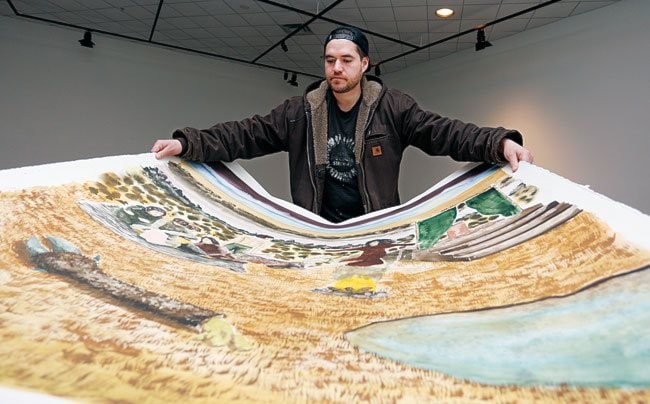When Joseph Tisiga was growing up he had an obsession with the number 2010. It was just a number seemingly pulled out of mid-air that stuck with him.
At first, it was innocent enough, but it took a darker turn in Tisiga’s teens. Whether because of the turmoil of those years or a heightened awareness of one’s own mortality that comes with growing up, as the year approached Tisiga came to believe 2010 would be the year of his death.
Of course, that premonition would prove to be false. Today, Tisiga is very much alive and producing some of the finest art of his burgeoning career.
Indeed, the last few years have looked favorably on the Whitehorse artist. In 2009 he was a semi-finalist in the RBC Canadian Painting Competition. (RBC would later acquire some of Tisiga’s work, as well as the National Gallery in Ottawa.) 2011 saw him among the 25 long-listed for the Sobey Art Award, one of the most prestigious artistic prizes in the country. Diaz Contemporary gallery in Toronto saw the waves Tisiga was making on the national scene and began representing him in 2013. His work has been reviewed by the Globe and Mail, the Toronto Star and numerous art publications.
Now, Tisiga is showing his latest offerings at the Yukon Arts Centre, in part influenced by the premonition of his demise in his earlier years. Indian Brand Corporation 1st Hole: Death Prophecy Denied is highlighted by large watercolours, and plays out across a bright green mini-golf putting green.
The paintings are of familiar Tisiga fashion: Earthen colours and organic lines reveal somber scenes that are often bizarre, with a pervading sense of uneasy calm. Recurring characters such as Red Chief or a bear find their way across multiple pieces.
In Sun Tea Beta Blockers, figures in pale green jumpsuits stand around an impromptu surgery. A man on the wooden plank is having his innards removed by an ominous green-clad doctor. Slumped over dead in his chair is a well-dressed bureaucrat, mauled by a roaming black bear. The dull red ground and washed out sky evokes a dream-like atmosphere.
Many would call his work surrealist, but Tisiga is reluctant to allow his work to fall into simple categories. “I definitely have an affinity for surrealism, but by no means am I interested in that being a signifier of what I’m doing,” Tisiga says.
When pressed for a description of his work, he offers: “I don’t know, maybe a dystopic romanticism or something.”
In the past, social and political statements in Tisiga’s pieces have been more obvious and explicit. More cognitive aerobics are required when journeying through the many layers Tisiga presents in his new work. “I look at it as stacking symbols,” he says.
Often, multiple figures - such as a man felling a hydro pole, or a makeshift operation theatre - work together to uncover a poetic, multifaceted story.
Continuing with his commentary on the intersection between indigenous and colonial, in Death Prophecy Denied Tisiga - himself belonging to Kaska Dene heritage - connects his personal death prophecy with that of Canada’s First Nations.
Just like Tisiga, First Nations in Canada did not die off, even though there was an effort on the part of the colonists to see that happen, he says, pointing to the abuses suffered at residential schools.
“Historically that was very overt.”
Now it looks different, he says. While First Nations populations may be growing, he worries about cultural erosion, which is evidenced partly by the gradual decline of many indigenous languages.
In Tisiga’s story, his premonitions of death led him to act in certain ways, such as not making many plans past 2010. When the date passed and the curse was broken, so to speak, his life underwent a change.
So too, Tisiga says, when aboriginal people weren’t snuffed out in the 19th and 20th centuries, there was a cultural shift.
“We’re not looking at death, we’re looking at some kind of evolution,” he says. “You could just as well characterize it as a transformation.”
Death Prophecy Denied opened yesterday and will run until May 28. Also being exhibited are Michael McCormack’s Station, and Josh Winkler’s Cut Climb Conquer, American Landscape Narratives.
Contact Joel Krahn at
joel.krahn@yukon-news.com
